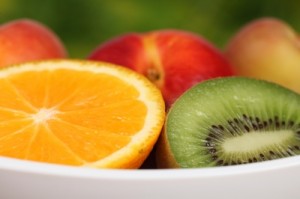Different Food Sources of Vitamin A
 Vitamin A is widely distributed among animal and plant sources of our food. In animal foods vitamin A is present as preformed vitamin A (retinol) and in plant foods vitamin A is present as provitamin (carotenes, such as beta carotene).
Vitamin A is widely distributed among animal and plant sources of our food. In animal foods vitamin A is present as preformed vitamin A (retinol) and in plant foods vitamin A is present as provitamin (carotenes, such as beta carotene).
The vitamin A value of food is expressed as retinol activity equivalent (RAE). One RAE is equivalent of 1 mcg (microgram) of retinol, 12 mcg of beta carotene, and 24 mcg of other provitamin-A carotenoids.
Animal Sources of Vitamin A:
Liver, egg and fish are excellent source of vitamin A (preformed vitamin A). Other rich sources of vitamin A of animal origin include butter, cheese, meat etc. The richest natural source of vitamin A is fish liver oil (cod liver oil, halibut liver oil etc.), but fish liver oil is generally used as dietary supplement for vitamin A deficiency, rather than as diet or food source of vitamin A. Presence of fat in the diet aid absorption of vitamin A as it is fat soluble vitamin.
Plant Sources of Vitamin A:
Very cheap and rich plant source of vitamin A are green leafy vegetables such as spinach, amaranth, cabbage etc. Other rich plant sources of vitamin A include colored vegetables (tomato, pumpkin, carrots, beet root etc.) and fruits like papaya, orange, mango, pineapple, brown grapes etc. The darker the vegetable generally the better is the vitamin A content of the vegetable. Moderate cooking of vegetables enhances carotenoid release for uptake in the gut and help in absorption of vitamin from gut due to higher availability.
Fortified Foods for Vitamin A:
Foods fortified with vitamin A are also very important sources of vitamin A. Vitamin A fortification of foods is done for providing adequate (recommended amount) vitamin A to general population. Food fortification (with vitamin A) is done for milk, cooking oils, ghee, butter etc.
Some foods with vitamin A content in micrograms/100 gram:
- Halibut liver oil- 900,000 mcg/100 grams
- Cod liver oil- 18,000 mcg/100 grams
- Liver (beef) â€" 16,500 mcg/100 grams
- Egg- 140 mcg/100 grams
- Butter- 825 mcg/100 grams
- Cheese- 350 mcg/100 grams
- Milk (cow) â€" 38 mcg/100 grams
- Fish- 40 mcg/100 grams
- Carrot- 1167 mcg/100 grams
- Spinach- 607 mcg/100 grams
- Green leaves- 300 mcg/100 grams
- Amaranth- 515 mcg/100 grams
- Tomato- 84 mcg/100 grams
- Mango- 313 mcg/100 grams
- Orange- 25 mcg/100 grams
The liver is the store house for vitamin A in humans and other animals, so liver is a rich source of vitamin A. Vitamin A is stored in liver in the form of retinol palmitate. In normal person the store in liver can supply vitamin A requirement for 6-9 months or more. So in general vitamin deficiency means, it is long term deficiency.
Image: luigi diamanti / FreeDigitalPhotos.net
Related posts:



0 Response to "Different Food Sources of Vitamin A"
Post a Comment